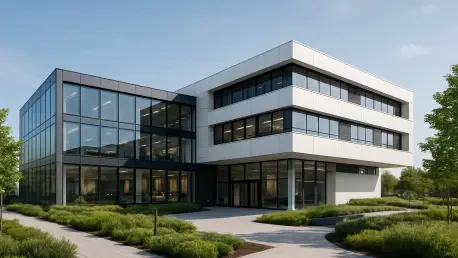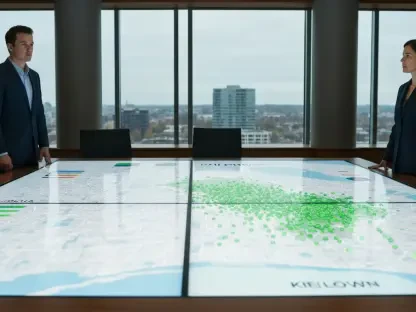Picture a workspace that transcends the ordinary, where innovation and design converge to create an environment that feels like a glimpse into tomorrow’s world of work, nestled in Boston’s vibrant Innovation District. At 10 World Trade, a trailblazing structure redefines what a smart building can achieve, designed by the acclaimed architectural firm Sasaki, seamlessly integrating breathtaking aesthetics with state-of-the-art technology, and setting an ambitious new benchmark for commercial real estate. At the core of its vision lies an unwavering commitment to connectivity, powered by advanced indoor 5G solutions that ensure everyone—tenants, visitors, and vendors—remains effortlessly linked to the digital landscape. This building isn’t just a place to work; it’s a bold statement about the future of intelligent workspaces, where digital infrastructure is as vital as the walls themselves. As technology continues to shape how spaces are utilized, 10 World Trade stands as a pioneering example of what’s possible when vision meets execution.
Transforming Work Environments with Digital Infrastructure
In today’s fast-paced, tech-driven world, the notion of connectivity as a luxury in commercial spaces has been firmly left behind, and 10 World Trade exemplifies this paradigm shift. Digital infrastructure is embedded into the building’s core, treated with the same importance as electricity or climate control systems. However, the robust construction—featuring a steel frame, concrete core, and triple-pane windows—presents significant hurdles for wireless signal penetration. To overcome this, a strategic collaboration with a leading tech provider has introduced the Ericsson Radio Dot System, a carrier-grade indoor 5G solution that guarantees consistent coverage across all major mobile networks. This isn’t merely about maintaining an internet connection; it’s about fostering an environment where productivity and innovation can thrive without interruption. The seamless integration of such technology ensures that occupants can rely on their devices for both personal and professional needs, no matter where they are in the building.
The impact of this digital foundation at 10 World Trade extends far beyond basic connectivity, reshaping how tenants interact with their surroundings. With reliable 5G coverage, businesses can leverage a wide array of applications, from cloud-based collaboration tools to real-time data analytics, without the frustration of dropped signals or inconsistent performance. This level of dependability is particularly crucial in a structure designed with dense materials that naturally obstruct wireless transmission. By prioritizing such infrastructure from the ground up, the building addresses a critical need in modern real estate: the expectation of uninterrupted digital access as a standard amenity. Furthermore, this approach signals a broader industry trend, where developers recognize that advanced connectivity solutions are essential for attracting and retaining high-value tenants in a competitive market. The result is a workspace that not only meets current demands but is also poised to adapt to future technological advancements.
Blending Aesthetic Excellence with Practical Innovation
Beyond its technological prowess, 10 World Trade captivates with a design that marries visual splendor with functional intent, creating a workspace that inspires at every turn. Often hailed as a “beacon of modernity,” the building features striking Gothic arches in its atrium, evoking the timeless grandeur of historic cathedrals while grounding itself in contemporary purpose. This architectural choice transcends mere decoration, crafting an atmosphere that uplifts the daily experience of those who work within its walls. The design reflects a deliberate intent to make the environment not just a place of business, but a source of inspiration that enhances creativity and well-being. Coupled with sustainable elements like energy-efficient smart windows, the building demonstrates a commitment to both beauty and environmental responsibility, setting a high standard for what smart workspaces can embody.
This fusion of form and function at 10 World Trade serves as a model for how architecture can elevate the purpose of commercial spaces in meaningful ways. The thoughtful integration of cutting-edge features alongside awe-inspiring design ensures that the building is more than a collection of offices—it’s a destination that redefines the work experience. Tenants benefit from an environment that prioritizes efficiency through sustainable systems, while the aesthetic elements create a sense of pride and connection to the space. Industry observers note that such a balance is rare, positioning this structure as a benchmark for future developments aiming to harmonize visual appeal with practical innovation. As the real estate sector evolves, this approach highlights the potential for buildings to serve as catalysts for inspiration, proving that workspaces can be both highly functional and deeply motivating.
Embracing the Rise of 5G in High-Traffic Settings
A notable trend taking shape at 10 World Trade is the increasing reliance on 5G networks over traditional Wi-Fi, marking a significant shift in how connectivity is delivered in modern environments. Unlike Wi-Fi, which often necessitates manual logins and can struggle under heavy user loads, 5G offers automatic, seamless connections through neutral host and private network setups. This is particularly advantageous in spaces frequented by diverse groups—such as visitors, contractors, and clients—where ease of access is paramount. Additionally, in industrial contexts embracing Industry 4.0, 5G supports specialized tools and applications with unmatched reliability. At this Boston-based building, 5G isn’t just an added feature; it’s a transformative force that reimagines how spaces are utilized and experienced by a wide range of occupants.
The preference for 5G at 10 World Trade also reflects broader industry dynamics, where the technology’s capacity to handle varied traffic—from personal devices to enterprise systems—positions it as the superior choice for future-ready spaces. This shift is evident in environments with high connectivity demands, where the ability to instantly link devices without cumbersome authentication processes enhances efficiency and user satisfaction. Experts highlight that 5G’s robust performance in such settings addresses longstanding pain points associated with traditional networks, paving the way for smoother operations in both commercial and industrial applications. As more buildings adopt this technology, the standard for digital access in shared spaces is being redefined, with 10 World Trade leading the charge. This trend underscores the critical role of advanced networks in meeting the evolving expectations of a digitally dependent workforce and visitor base.
Meeting the Non-Negotiable Demand for Seamless Access
Among the key insights from the development of 10 World Trade is the unanimous view that connectivity has become a fundamental expectation in today’s commercial properties, no longer seen as an optional perk. In a structure built with dense materials that naturally impede wireless signals, ensuring seamless indoor coverage is essential for everyone who steps inside—be it tenants conducting business, visitors attending meetings, or vendors providing services. Industry leaders involved in the project describe this level of digital access as “table stakes” in the current real estate market, where the ability to stay connected can significantly influence a property’s appeal and value. This building meets that demand with precision, distinguishing itself as a leader in a landscape where reliable connectivity is a decisive factor for success.
This expectation of constant digital access at 10 World Trade highlights a critical shift in tenant priorities, where the quality of connectivity can directly impact business operations and user experience. The building’s design acknowledges that in an era of remote collaboration and mobile-first workflows, any lapse in network performance can disrupt productivity and frustrate occupants. By addressing these challenges head-on with advanced solutions, the property not only satisfies immediate needs but also builds trust with its users, reinforcing its position as a top-tier destination for forward-thinking businesses. This focus on seamless access also mirrors a wider trend in commercial real estate, where developers are increasingly held accountable for delivering robust digital infrastructure as part of their value proposition. As expectations continue to rise, properties that fail to meet these standards risk falling behind in an ever-competitive market.
Leveraging Strategic Alliances for Technological Success
The remarkable achievements at 10 World Trade would not have been possible without the power of strategic partnerships, particularly with a globally recognized technology leader like Ericsson. Trusted for its reliability and industry expertise, Ericsson delivers a unified, carrier-grade solution that supports all major mobile networks from the moment the building opens its doors. This collaboration has proven instrumental in overcoming the connectivity challenges posed by the structure’s dense construction, ensuring that tenants and visitors experience no gaps in service. Beyond solving immediate technical needs, this partnership has also inspired innovative approaches to integrating technology throughout the space, demonstrating how such alliances can elevate the functionality and appeal of modern workspaces.
The collaboration at 10 World Trade serves as a compelling case study for the importance of aligning with established tech providers to navigate the complexities of smart building development. Ericsson’s role extends beyond mere implementation; it acts as a backbone for consistent performance, simplifying deployment and troubleshooting for all stakeholders involved. This relationship has enabled the project team to explore creative applications of the Radio Dot System, tailoring solutions to the building’s unique needs and setting a precedent for future projects. As the demand for intelligent, connected environments grows, such partnerships highlight the necessity of leveraging proven expertise to achieve ambitious goals. The success of this endeavor underscores a vital lesson for the industry: strategic alliances with trusted innovators are key to transforming visionary concepts into tangible, impactful realities.
Pioneering a New Era of Intelligent Design
Reflecting on the journey of 10 World Trade, it’s evident that this Boston landmark has redefined the possibilities of smart workspaces through a bold integration of technology and design. The deployment of indoor 5G solutions via the Ericsson Radio Dot System tackled the persistent challenge of signal interference, while the building’s captivating architecture inspired all who entered. Stakeholders united in their belief that connectivity stood as a cornerstone of modern real estate, a view that shaped every decision in the project’s development. Looking ahead, the lessons from this endeavor offer a roadmap for developers aiming to create future-ready spaces—prioritizing digital infrastructure, embracing aesthetic innovation, and forging impactful partnerships. As the industry evolves, the focus should remain on anticipating tenant needs with scalable solutions that enhance both functionality and experience, ensuring that tomorrow’s buildings continue to push boundaries in meaningful ways.









